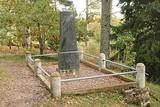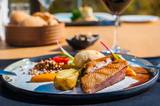| Nr | Nosaukums | Apraksts |
|---|---|---|
|
Varenās muižas Alatskivi galvenajā ēkā esošajā restorānā goda vietā ir vietējie ēdieni. Muižas bagātā vēsture saista igauņu zemnieku kultūru, baltvāciešu kultūru un muižas arhitektūrā atspoguļoto skotu kultūru. Restorāna ēdienkartē apvienotas šīs trīs vērtības. Viesi iecienījuši galvenokārt Peipusa zandartu un cūkgaļas karbonādi, taču bieži tiek slavēts arī skotu pārsteiguma deserts un vietējais sīpolu ievārījums. |
||
|
Piedāvā iepazīt savvaļas augus un to lietojumu uzturā un cilvēku veselības stiprināšanā. Vada meistarklases savvaļas augu ēdienu gatavošanā, vada atbilstoša satura izzinošas ekskursijas Pāvilostas apkaimē. |
||
|
Līgatnes dabas takas, dibinātas 1975. gadā, ar mērķi iepazīstināt parka apmeklētājus ar Latvijas dabu, vietējo augu un dzīvnieku valsti, savvaļas zīdītājdzīvnieku sugām, dabas bioloģisko daudzveidību un aizsardzību. Pirmie Līgatnes dabas taku iemītnieki bija seši staltbrieži un meža cūkas. Līgatnes dabas takās apskatāmi dažādu savvaļas sugu dzīvnieki, vērojamas neskartas dabas ainavas (arī no 22 metrus augstā skatu torņa), saklausāmas mežu un pļavu balsis, skatāma krāšņu gravu un klinšu ieskauta Gauja un tās senleja, kā arī baudāma aktīva atpūta un brīnišķīgs miers. |
||
|
The route leads through the Gauja National Park which is located on both sides of the ancient Gauja river valley. Sandstone cliffs and caves, hilly landscapes and deep forests and castles are characteristic of the park. Further on at Igate Manor stop for a lunch at their mill tavern to taste traditional Latvian food. The route turns towards the coastwhich belongs to the North Vidzeme Biosphere Reserveand continues through old Estonian fishing villages before arriving at the seaside resort of Parnu with its elegant villas. Next is a guided wilderness day in Soomaa National Park trying old-fashioned bog-shoeing and canoeing. Further on the route you will pass Pootsi with a 19th century manor and the ancient village of Varbla. Take a ferry to Muhu island and stay in the ethnographic fishermen's village of Koguva for a couple of days to explore the area. Cycle across the causeway to Saaremaa island from where you can take a ferry to laid-back Hiumaa island for a day trip to get a feeling for the true spirit of Estonia. Back on Saaremaa there is time for a free day in its capital, Kuressaare with plenty of spa and relaxation facilities. Then by bus head to Tallinn, charming with its medieval Old Town. From there enjoy a day trip to the former military base of Naissaar island where special cycling routes showcase its military history, mine and nature reserves. |
||
|
Saimniecībā audzē un vāc ~ 80 ārstniecības augus – piparmētru, kliņģerītes, kumelītes, raudenes, asinszāles, vērmeles, auzas, mārsilu, ceļmallapas, nauduļus, vīgriezes u.c. Saimnieks vada ekskursiju, stāsta par ārstniecības augiem un to pielietojumu. Rudeņos piedāvā ārstniecības augu tēju iegādi. |
||
|
Teritorijas apskates nolūkos ir izveidota un labiekārtota dabas izziņas taka. Dabas liegums atrodas Abavas senlejas dabas parka teritorijā. Taka iepazīstina ar vienīgo krūmu čužas savvaļas augšanas vietu Latvijā. |
||
|
Apmeklētāju centrā var iegūt noderīgu informāciju un iepazīt ekspozīciju par Karulas augstienes veidošanās vēsturi, ezeru iemītniekiem un šejienes novada kultūrvēsturiskajām tradīcijām. Apmeklētāju grupas semināru zālē var noskatīties izzinošu prezentāciju. |
||
|
Rakstnieka Marģera Zariņa stāstā un lugā
aprakstītā vecā Taizeļa prototipa – zvejnieka Nika Freimaņa (1845. – 1908.) kaps.
|
||
|
Lūznavas muižas apbūve sākusies 1905. – 1911.g. romantiskajā jūgendstilā. Lūznavas muižas īpašnieks bija Krievijas inženieru korpusa ģenerālis, profesors, Pēterburgas Zinātņu akadēmijas goda loceklis, pēc tautības polis, Staņislavs Kerbedzs (1810.-1899.), kurš pēc profesijas bija dzelzceļu inženieris. S.Kerbedzs bija pirmais Krievijas inženieris, kurš izstrādāja tiltu arhitektoniskā risinājuma principus, pēc kuriem vadījās 19. gs. otrajā pusē. Viņa vadībā cēla Blagoveščenskas tiltu pāri Ņevai Sanktpēterburgā. S.Kerbedza meita Jevgenija bija pazīstama kā mākslas mīļotāja, kura no Itālijas vedusi dažādus mākslas priekšmetus. Tādejādi Lūznavas muiža vasarās kļuva par iecienītu mākslinieku atpūtas vietu. Te viesojies slavenais lietuviešu gleznotājs un komponists M.K.Čurļonis. Mūsdienās Lūznavas muižu ieskauj 23,7 ha liels ainavu parks ar 7 dīķu sistēmu. Netālu no muižas – parkā atrodas Madonnas skulptūra. Īstais skulptūras autors īsti nav zināms, viena no versijām, ka skulptūra ir gatava atvesta no Itālijas un uzstādīta, otra versija, ka skulptūras autore varēja būt poļu tēlniece Jūlija Stabrovska, kura vasarās ir ciemojusies Lūznavas muižā. 20.gs. 50.gados skulptūra tika nogāzta no pjedestāla un iegrūsta dīķī. 1991.gadā tika uzstādīta un iesvētīta jaunā skulptūra. Muiža un parks ir apskatāma gan individuāli, gan gida pavadībā. |
||
|
Viesītes muzeju “Sēlija” veido 2 nodaļas – Mazā Bānīša parks un Paula Stradiņa skola. Ekspozīcijas vēstī par Sēlijas šaursliežu dzelzceļa vēsturi, Sēlijas kultūrvēsturi, Stradiņu dzimtu, medicīnas vēsturi Viesītes apkārtnē, Stenderu dzimtu, amatniecību, Viesītes pilsētas un tuvākās apkārtnes vēsturi un ļaudīm. Muzejs izveidots 2000. gadā un tā nozīmīga ekspozīcijas daļa atrodas bijušā šaursliežu dzelzceļa depo ēkā (dzelzceļš darbojās laikā no 1916. – 1972. g.), kur novietota atjaunotā lokomotīve, pasažieru vagons, drezīna u.c. Muzejā apskatāmi eksponāti, kas atspoguļo Viesītes un plašākas teritorijas ievērojamāko personību dzīves gājumu, notikumus un kultūras mantojumu. |
||
|
Bijušais kursenieku zvejniekciems Kuršu jomas krastā. Jau no 19. gs. sākuma tas ceļojošo kāpu dēļ ir vairakkārt mainījis savu atrašanos un tagadējā vietā pastāv aptuveni gadsimtu. Ciematā uz dzīvi apmetās smilšu kāpu apbērto Nagļu (Naglių) un Karvaiču (Karvaičių) ciema iedzīvotāji. Kuršu kāpu mazākā ciema kultūrainavu veido gan gadsimtu vecas koka dzīvojamās ēkas, gan arī mūsdienās celtās. Kā vienas, tā otras kalpo g.k. kā vasarnīcas un viesu izmitināšanas vietas. |
||
|
Perispeas pussalas piekrastē ir izvietojušies gan bijušie zvejniekciemi, gan Padomju armijas kara bāzu atliekas. Viena no pussalas savdabībām ir arī grandiozie ledāja atnestie dižakmeņi: nezinātājam ne visai viegli atrodamais un grūti pieejamais (jūrā) Odakivi, Purekari raga (Purekkari neem) galā starp citiem akmeņiem guļošais Purekari akmens (Purekkari rändrahn), jūras apskalotie Mehu akmeņi (Mähu kivid), Vīnistu (Viinistu) ciema krastmalā guļošais Melnais akmens (Must kivi), pāri niedru galotnēm savu „virsotni” izslējušais Kuhjakivi, visnotaļ iespaidīgais Painuva kivi, līdz kuram var nokļūt tikai peldus un savā ziņā nepārspējamais Jaani – Tooma suurkivi. Četri no pieminētajiem akmeņiem ir sasnieguši vai pat pārsniedz piecu metru augstumu! Akmeņiem bagāts ir Turbunēmes (Turbuneeme) ciems. Būs nepieciešams patiess entuziasms un laiks, lai visus uzskaitītos milžus atrastu un iemūžinātu savā fotokolekcijā. Perispeas pussala beidzas ar tālāko Igaunijas sauszemes ziemeļu punktu – Purekari ragu, kas ir ļoti ainaviska vieta. |
||
|
Tikai 30 minūšu braucienā no Rīgas, pašā Ogres centrā atrodas "SierŠtelles" ražotne. Turpat atpūtas kompleksā „Policijas akadēmija” var nobaudīt "SierŠtelles" siera ēdienus, kā arī iegadāties sierus kulinārijā. „SierŠtelles” sortiments sastāv no 31 dažādas garšas siera – gan sāļajiem, gan saldajiem. Īpašā siera recepte dzimusi turpat Ogrē, populārajā Peldu kūrortā. |
||
|
Meklējama starp Pīlādžu ielu un Siliņupes kreiso krastu. III – II g.t. pr. Kr. šeit atradās zvejnieku un mednieku apmetne, kuras vietā uzstādīts informējošs piemiņas akmens (tēln. O. Skarainis). Siliņupes apmetne ir senākā zināmā cilvēka apdzīvotā vieta Ķemeru nacionālā parka teritorijā. Šeit atrastas daudzas senlietas: māla trauku lauskas, bultu uzgaļi, krama un dzintara gabaliņi u.c. Iespējams, ka blakus esošo privātmāju teritorijā ir atradies apmetnes kapulauks. Neliela daļa no atradumiem apskatāma Lapmežciema muzejā, pārējie atrodas Latvijas Nacionālajā vēstures muzejā. |
||
|
No teikām un nostāstiem apvītā stāvā paugura (ap 66 m virs tuvākās apkārtnes) dienvidu nogāzes skatu stigas paveras skats uz Burtnieku līdzenumu. Tornis nav publiski pieejams.
|
||
|
Atrodas Rīgas - Bauskas šosejas 25. kilometrā pie Ķekaviņas upītes. |
||
|
Restorāns atrodas skaistā vietā ar stāstu un nākotni - Amatciemā. "Jonathan" restorāns izmanto vietējos produktus no zemnieku saimniecībām, lai ēdienus pasniegtu mūsdienīgā interpretācijā, uzsvaru liekot uz garšu un kvalitāti. Ir daļa no Jonathan SPA Estate kompleksa, kurā ir viesnīca un SPA. |
||
|
Vējupītes grava ir domāta tiem, kurus nebaida vairāki gari un stāvi kāpieni pa koka kāpnēm, kas ved pa augstajām Vējupītes gravas nogāzēm. Ja aiz viesu nama „Līvkalns" kāpsim lejup, nonāksim pie seklās (3,6 m), bet augstās (6,1 m) Pētera alas , kas atgādina plaisveidīgu nišu. Pēc ~ 10 min ilga gājiena pa upīti uz leju (Gaujas virziens), tās kreiso krastu pāršķeļ dziļā Pūču grava, pa kuru tek Kraukļupīte. Abu upes gravu saskares vietā paceļas Satezeles pilskalns (plakums 90 x 75 m), kur 13. gs. sākumā atradās feodāļa Dabreļa ozolkoka pils ar galveno ieeju pilskalna rietumu pusē. Līdz pilskalnam no Pūču gravas dziļumiem uzved koka kāpnes. Lai apskatītu Kraukļu aizu , ir atkal jākāpj lejup pa tām pašām trepēm un jāturpina ceļš Gaujas virzienā. Kraukļu aiza ir Vējupītes kreisā krasta sānu grava ar līdz 11 m augstām un iespaidīgām smilšakmens sienām, kurās izveidojusies 5,2 m dziļā Kraukļu ala. Vēl pēc aptuveni 10 – 15 min ilga gājuma (ir jāšķērso Vējupīte pa koka tiltiņiem) nonāksim pie kāpnēm, kas uzved Paradīzes kalnā (aprakstu sk. iepriekš pie Nr. 7.). |
||
|
Lietuviešu ārsta Vaclovas Intas (1925. – 2007.) veidotā akmeņu brīvdabas ekspozīcija un Unikālo akmeņu muzejs. |
||
|
Lietuvas galvaspilsēta. Viena no lielākajām Austrumeiropas vecpilsētām (iekļauta UNESCO Pasaules kultūras mantojuma sarakstā), kurā pārstāvēti dažādi arhitektūras stili - klasicisms, baroks, gotikas, renesanses u.c. |
||



















